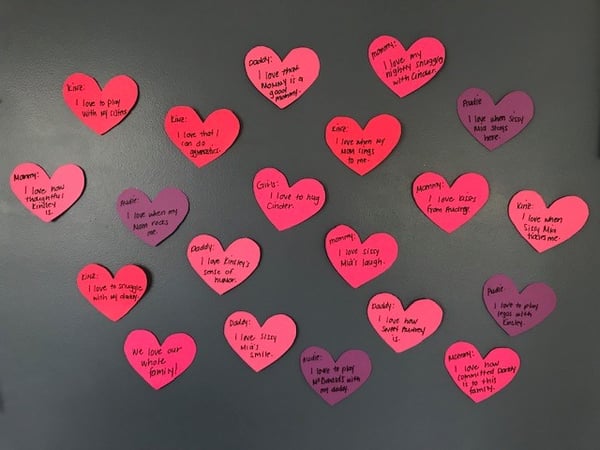
On Valentine’s Day, many people send cards, candy, or flowers to show their love for others. While these sentiments are thoughtful, do they really get to the heart of the holiday?
Traditionally, Valentine’s Day is the feast day of three saints in the Roman Catholic church (all named Valentine). The most famous St. Valentine was a Roman priest who lived in the mid- to late-200s. He was executed for his unceasing faith in God. Pope Gelasius deemed February 14 St. Valentine’s Day near the end of the fifth century, and it became known internationally during the 1500s.
No matter the reason you celebrate on Feb. 14, consider using this Valentine’s Day to encourage positivity in your students and children. It’s a great time of year to help them establish healthy ways to show love and kindness. Here are two simple ideas to get you started.
14 Ways to Say “I Love You”
Revealing what you value about others is one healthy way to express love. Sentiments of love in the classroom can be as simple as a compliment such as, “I love how you style your hair every day.” Validating children and adolescents in this way helps them feel reassured that they are special and that you notice their efforts.
In Class
The 14 Ways activity works well in a classroom and at home. In class, begin by having your students trace and cut out hearts on construction paper. Then, group students so that each student is assigned to 14 different peers.
Next, have students write about one feature for each student. You can also have them jot down 14 traits they love about themselves. Sometimes, it’s easy to see the authenticity in others, but it’s harder to see the best in ourselves.
If you have only a few minutes of class time to dedicate to this project, have students write one message per day. After 14 days, students can collect all their hearts, which could be placed in a decorative box, and read about all the wonderful things others have to say about them. If you want students to write about themselves as well, have them write one message to themselves and one to a peer.
At Home
To do this activity at home, begin the same way, by having your children trace and cut out hearts. If your children are too young to write, have a conversation about what each family member loves about the others. A designated writer can record the information on the paper hearts.
My little ones do not have the attention span to list 14 messages per person, so we created one heart per family member. We tacked them to the wall in our kitchen so that we can see how much love there is in our home.

14 Acts of Kindness
The 14 Acts of Kindness is an activity where everyone takes part in doing nice things for others without being asked. This activity can be done during any month and for as long as you choose. The idea is simple. Each day, help your children or students to brainstorm and complete one act of kindness. Track their progress on a bulletin board or wall in your home.
My co-worker Sarah Burns, Senior Manager of 9-12 Curriculum, recently completed 21 Acts of Kindness in January with her two small children. Here are a few examples of what she did:
![]() Make fudge and gift it to the neighbors.
Make fudge and gift it to the neighbors.![]() Create homemade cards and mail them to grandparents.
Create homemade cards and mail them to grandparents.![]() Clean up toys.
Clean up toys.![]() Share at church.
Share at church.![]() Buy coffee for the next person in line.
Buy coffee for the next person in line.
Sarah said her experience was fulfilling and that she made the list with her oldest daughter, Ava.
“I enjoyed helping Ava and Jackson spread love and show them how to be kind to others,” Sarah said. “It also helped me to be intentional about my actions and kindness throughout my day."
Sarah added that after she and her family finished the 21 acts, her daughter wanted to do more. Sarah decided to keep trying to incorporate kind acts throughout each week to help spread love.
"It really gets you thinking about others and loving others,” Sarah said.

Everyday Acts of Kindness
Remind your children that acts of kindness can be simple, everyday activities. For example, the other day, I found that my four-year-old had brought the folded laundry upstairs, without being asked to do so.
When I heard her loudly coming upstairs, I assumed she was dragging a large toy behind her. When I rounded the corner to see the laundry basket, my heart leapt because she was being so thoughtful and aware of others.
Of course, I praised her verbally and with a meaningful hug. It can be very hard for children to see from other perspectives—especially adults.
This act of kindness made my day, and I will forever remember it. The look on her face after the hug was just as special. In that moment, I could tell that she knew exactly how much I appreciated such a small gesture of thoughtfulness.
Teaching children to be kind is so important. It helps them learn how to empathize, how to be helpful, and how to show concern. These skills are essential for expressing love in healthy ways other than by saying, “I love you.”
On this Valentine’s Day—whether you’re baking cookies, buying chocolates and flowers, wrapping homemade gifts, or dining out—remember that even though love is only four letters, its expression can be done through small everyday actions that leave a lasting, meaningful impression.
 Nicole Thompson is a contributing writer and editor to the Lincoln Learning blog. She brings more than a decade of experience in education, curriculum, and communications to her blogs. She has a Bachelor of Arts in Communications and a Master of Science in Instructional Leadership, with certifications in secondary English and Communications. Nicole is married with four children and has a spunky golden retriever named Cinder and a rescue dog named Annie Banannie.
Nicole Thompson is a contributing writer and editor to the Lincoln Learning blog. She brings more than a decade of experience in education, curriculum, and communications to her blogs. She has a Bachelor of Arts in Communications and a Master of Science in Instructional Leadership, with certifications in secondary English and Communications. Nicole is married with four children and has a spunky golden retriever named Cinder and a rescue dog named Annie Banannie.
Related Posts
4 Ways to Add Music to Your Summer
No matter what age you are, music creates a fun and energizing atmosphere. Using music throughout...
Social-Emotional Development and the Connection to Kindness
Fostering acts of kindness is more important for humanity than ever before. Teaching kindness at...
Managing Work/Family During Social Distancing
Now that the United States has implemented social distancing to stop the spread of the Coronavirus,...

